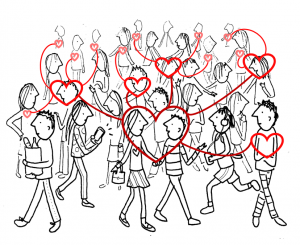increaseofsti’s

The number of sexually transmitted infections has risen again over the last few years (although the percentages given by the media are exaggerated as usual for the purpose of warning or sensation) after a period of relative uneventfulness.
The increase also occurs in Western countries with a tradition of sex education, availability of contraceptives and safe sex campaigns on which millions have been spent.
STI Campaigns
The general conclusion is that young people do not have safe enough sex. Of course there is nothing new in this. There have always been fluctuations in the behaviour of youngsters and the responses of their elders. There are two approaches to unsafe sexual intercourse among young people. One is to discourage sex among them, to tell them to save sex for marriage, in other words: abstain. The other is to accept that (some or most) young people will have sex whatever moralists and educators say, and that therefore it is better to ensure that they prevent pregnancy or STI’s. Campaigns on the basis of this more liberal attitude will be informative, non-frightening, will carry a positive image of youth and sex, and will stimulate an open and sensible attitude, especially in girls.
Succes of STI campaigns
Have such campaigns been successful? Yes and no. Yes, because the number of people practising safe sex has risen considerably, which is shown by the increase in sales of condoms, as well as in reported sexual activity among young people. If it had not been for the campaigns, the numbers of infected people would, we assume, have been higher.
Those who favour the ‘save sex’ approach, do not agree with this assumption. In fact, they blame the campaigns for the increase in STI’s among youngsters. The campaigns, they say, portray sex before marriage as something normal or even desirable, which encourages young people to engage in it prematurely.
This view comes from orthodox circles who continue to have surprisingly high membership and appeal, also among the young. Unfortunately, the theory of abstinence before marriage is less successful in the battle against sti than the educational campaigns, at least in the modern world.
STI campaigns are restricted in scope
The campaigns have been less successful than they might perhaps have been, because they are restricted in scope and subject matter. Mostly detached from the facts of life, intimate behaviour, communication about love and the emancipation of girls, the campaigns have been mostly warnings directed at mass audiences. Detached from lovemaking, which is far from self-evident among young people, the campaigns call for rational behaviour vis a vis sexual intercourse, assuming that young people will engage in ‘it’at some time or other. Thus the vague associations with ‘sex’ as meaning sexual intercourse (fucking) tend to reinforce the association of danger and mystery or create in many a sense of distaste about the lack of romance implied. Thus the chances of sexual intercourse being unplanned, because not consciously wanted, are increased.
STI campaigns are moralistic
Also, the campaigns are less effective in that they retain a few moralist characteristics. A well-known but mistaken idea is, for instance that promiscuity and sti are related, which goes back to the idea that sti’s are a punishment for sins committed. By emphasizing the idea that monogamy implies purity and absence of infection, the same message as that of the ‘save sex’ advocates is sent and received with the same connotation of fear, danger and risk that ‘sex’ has.
STI campaigns and sexual education
Another factor, difficult to cope with by warning campaigns, is the fact that young people are inclined to disregard advice from parents, and go against model behaviour advocated by adults.
Finally, it must be pointed out that there has been a general worsening of the general mood surrounding sexual behaviour. A general lack of good sex education at every type of school, the moral panic around stories of child abuse, rape, harrassment, the rise of sex-hostile feminism, the fear of aids, the systematic propaganda for the family in American cultural products especially, the increase in violence and cynicism shown on television, has increased fear, suspicion, racism, nationalism, agression and has decreased tolerance, openness and rationality. This is always accompanied by an increase in ‘unsafe’ behaviour.

